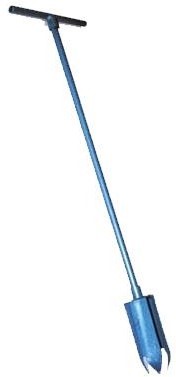
Sampling Augers are tools used for collecting samples from soil, aggregates, or other granular materials. They are essential for obtaining representative samples from different depths and locations, ensuring that the material sampled is indicative of the entire batch or area.
- Shaft:
- The long, cylindrical part of the auger that allows it to reach into the ground or material. It can vary in length depending on the depth required for sampling.
- Auger Bit:
- The helical or spiral component attached to the shaft. It is designed to dig into the material and lift it out. The bit’s design can vary based on the material being sampled (e.g., soil, aggregates).
- Handle:
- A handle or grip is attached to the shaft to provide leverage and control during sampling. It can be a single or double handle, depending on the design.
- Sampling Head:
- The end of the auger bit that makes contact with the material. It is designed to capture and hold the sample as the auger is withdrawn.
- Material:
- Sampling augers are typically made from durable materials such as steel or aluminum to withstand the forces involved in sampling and the materials they are used with.
- Soil Augers:
- Designed for sampling soil. They often have a sharp, cutting edge to penetrate soil layers effectively.
- Aggregate Augers:
- Used for sampling aggregates. These augers may have a more robust design to handle the harder materials.
- Geological Augers:
- Used for specialized geological sampling. They may have specific features to handle various soil types and rock formations.
- Preparation:
- Ensure the sampling auger is clean and in good working condition. Select the appropriate size and type of auger based on the material and depth required.
- Inserting the Auger:
- Insert the auger into the material at the desired location. Rotate the auger to allow the bit to penetrate the material and collect a sample.
- Extracting the Sample:
- Once the auger has reached the desired depth, carefully withdraw it from the material. The sample should be held within the auger bit or on the sampling head.
- Sample Collection:
- Remove the material from the auger bit and transfer it to a suitable container for analysis. Ensure that the sample is representative of the entire batch or area.
- Cleaning:
- Clean the auger thoroughly after each use to prevent cross-contamination between samples and to maintain the tool’s condition.
- Soil Testing:
- Collecting soil samples for analysis in construction, agriculture, and environmental studies.
- Aggregate Testing:
- Sampling aggregates for quality control in construction and manufacturing processes.
- Geological Surveys:
- Obtaining samples from different soil layers or rock formations for geological and environmental studies.
- Environmental Monitoring:
- Collecting samples from contaminated sites or other areas for environmental analysis.
- Representativeness:
- Ensures that samples accurately represent the material being tested, which is crucial for reliable analysis and decision-making.
- Accuracy:
- Provides accurate data on the material’s properties, which can affect the quality of construction projects, agricultural practices, and environmental assessments.
- Efficiency:
- Allows for efficient and systematic sampling, especially from deeper or hard-to-reach areas.
Sampling Augers are essential tools in various industries for obtaining representative samples of soils, aggregates, and other granular materials, ensuring accurate analysis and effective decision-making.